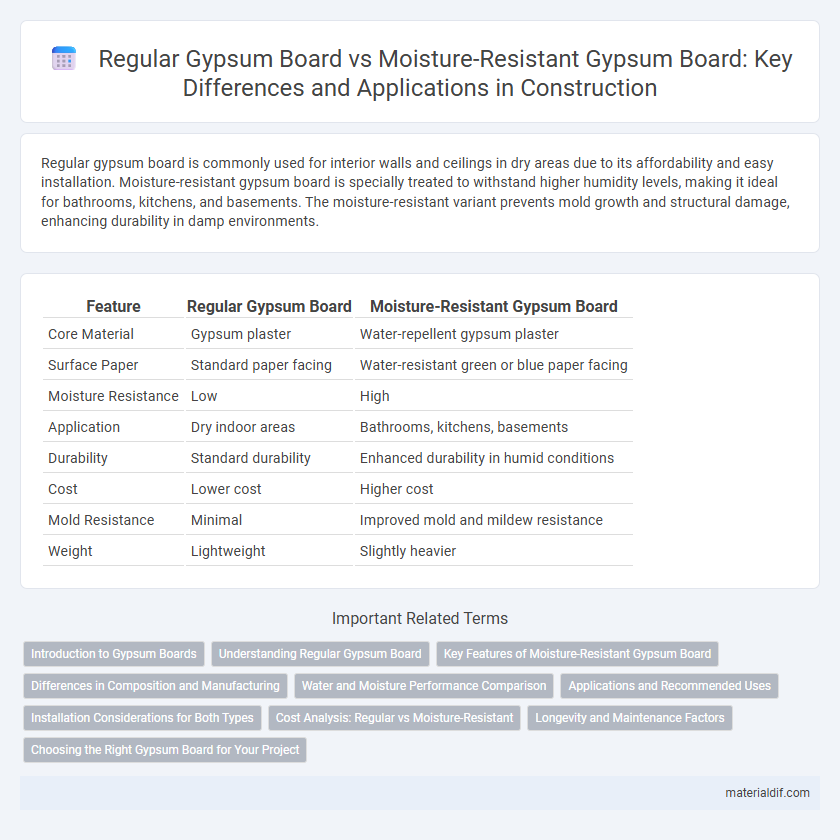Regular gypsum board is commonly used for interior walls and ceilings in dry areas due to its affordability and easy installation. Moisture-resistant gypsum board is specially treated to withstand higher humidity levels, making it ideal for bathrooms, kitchens, and basements. The moisture-resistant variant prevents mold growth and structural damage, enhancing durability in damp environments.
Table of Comparison
| Feature | Regular Gypsum Board | Moisture-Resistant Gypsum Board |
|---|---|---|
| Core Material | Gypsum plaster | Water-repellent gypsum plaster |
| Surface Paper | Standard paper facing | Water-resistant green or blue paper facing |
| Moisture Resistance | Low | High |
| Application | Dry indoor areas | Bathrooms, kitchens, basements |
| Durability | Standard durability | Enhanced durability in humid conditions |
| Cost | Lower cost | Higher cost |
| Mold Resistance | Minimal | Improved mold and mildew resistance |
| Weight | Lightweight | Slightly heavier |
Introduction to Gypsum Boards
Gypsum boards are widely used in construction for wall and ceiling applications, with Regular Gypsum Board offering a smooth, fire-resistant surface ideal for dry areas. Moisture-Resistant Gypsum Board incorporates water-repellent additives and fiberglass mats to prevent mold and deterioration in humid environments. Choosing the appropriate gypsum board depends on the specific moisture exposure and performance requirements of the installation site.
Understanding Regular Gypsum Board
Regular gypsum board consists of a gypsum core sandwiched between two layers of paper and is widely used for interior walls and ceilings due to its fire-resistant and soundproofing properties. It is suitable for areas with low moisture exposure, such as living rooms and bedrooms, but it lacks the specialized moisture-resistant additives found in moisture-resistant gypsum boards. Understanding these limitations is crucial for selecting the right gypsum board to prevent mold growth and material degradation in humid environments.
Key Features of Moisture-Resistant Gypsum Board
Moisture-resistant gypsum board features a water-repellent core and a special paper facing treated to inhibit mold and mildew growth, making it ideal for damp environments such as bathrooms and kitchens. Its enhanced durability withstands humidity and occasional water exposure better than regular gypsum board, which is susceptible to swelling and deterioration when wet. This board also offers improved dimensional stability and fire resistance, ensuring long-lasting performance in moisture-prone areas.
Differences in Composition and Manufacturing
Regular gypsum board consists primarily of a gypsum core sandwiched between paper facings, offering standard fire resistance and structural properties. Moisture-resistant gypsum board incorporates water-repellent additives like wax or silicone within the gypsum core and features fiberglass mat facings instead of paper, enhancing its durability in humid environments. Manufacturing processes for moisture-resistant boards include specialized treatments that improve resistance to mold, mildew, and moisture absorption compared to regular gypsum board production.
Water and Moisture Performance Comparison
Regular gypsum board absorbs water quickly and loses structural integrity when exposed to moisture, making it unsuitable for high-humidity areas. Moisture-resistant gypsum board contains additives like fiberglass or wax, enhancing its ability to repel water and prevent mold growth. These properties make moisture-resistant boards ideal for bathrooms, kitchens, and basements where prolonged exposure to moisture is common.
Applications and Recommended Uses
Regular gypsum board is widely used for interior walls and ceilings in dry environments due to its cost-effectiveness and ease of installation. Moisture-resistant gypsum board, often referred to as green board, is specifically designed for high-humidity areas such as bathrooms, kitchens, and basements, where moisture exposure is frequent. Its enhanced water-repellent properties prevent mold growth and structural damage, making it the preferred choice for wet or damp conditions.
Installation Considerations for Both Types
Regular gypsum board requires careful handling to avoid moisture exposure during installation, as it is susceptible to mold and deterioration in damp environments. Moisture-resistant gypsum board features a water-repellent core and paper facing, allowing for more flexible use in high-humidity areas like bathrooms and kitchens, but installation must still ensure proper sealing of joints and edges to maintain resistance. Both types benefit from precise cutting, secure fastening, and appropriate joint treatment to optimize durability and finish quality.
Cost Analysis: Regular vs Moisture-Resistant
Regular gypsum board typically costs 15-25% less than moisture-resistant gypsum board due to its standard paper facing and lack of water-repellent additives. Moisture-resistant gypsum board contains additives like fiberglass mesh and water-repellent coatings, increasing its price but significantly extending durability in damp environments. Evaluating initial expenses against long-term benefits helps determine cost-effectiveness, especially in moisture-prone areas such as bathrooms and basements.
Longevity and Maintenance Factors
Regular gypsum board offers adequate durability for typical indoor applications but is more susceptible to water damage, leading to reduced longevity and increased maintenance in humid environments. Moisture-resistant gypsum board features enhanced water-repellent additives and fiberglass mats, significantly improving resistance to mold, mildew, and warping, thereby extending lifespan and lowering upkeep requirements. Selecting moisture-resistant variants is crucial for bathrooms, kitchens, and basements to ensure structural integrity and reduce long-term repair costs.
Choosing the Right Gypsum Board for Your Project
Regular gypsum board is ideal for interior walls and ceilings where moisture exposure is minimal, offering affordability and ease of installation. Moisture-resistant gypsum board contains treated paper facings and additives that inhibit mold and mildew growth, making it suitable for bathrooms, kitchens, and basements with higher humidity levels. Selecting the right gypsum board depends on assessing the environmental conditions of the project area, ensuring durability and long-term performance.
Regular Gypsum Board vs Moisture-Resistant Gypsum Board Infographic

 materialdif.com
materialdif.com